Tim Omilusik is a 42-year-old Canadian trucker from Coronation, Alberta, who runs a short- and long-haul livestock business from one end of Canada to the other, with 2,000-mile trips across the border down into Texas in between—or maybe a leg to Missouri or Wyoming.
Bison loads preferred. In fact, he says, he now hauls only buffalo to the USA.
Omilusik shares his bison-moving adventures on Twitter. A man of few words—Twitter is an ideal platform for him.

Omilusik shares his bison-moving adventures on Twitter. Bison loads preferred. Photo courtesy of Tim Omilusik.
“Bunch of beauties!
“Oh my goodness. These are big boys.
“Majestic!
“Beautiful set of bull calves. Very quiet. It was a long journey for them.
“Speedy ladies…..Don’t matter how fast you think you are, you ain’t beating no bison. So incredibly athletic”
There’s an appreciation for the scenery:
“You can’t beat the fresh mountain air.
“Scenic rip through Montana
“Idaho skies.” A brilliant sunrise—or sunset.
On some days he only gives his viewer-readers a video—no words.
Sure enough, a video tells it all.
He provides great movies of buffalo charging into the big trailer—with large grunting, groaning sound effects.
Oh my goodness. These are big boys. pic.twitter.com/5lziLd5eFI
— Eastland Transport Ltd (@eastland09) April 14, 2021
Big bulls duck their gigantic heads to avoid scraping the ceiling—as they lunge up or down a ramp to other decks. Credit TO.
Big bulls duck their big heads to avoid scraping the ceiling—as they lunge up or down a ramp to another deck.
Now and then it’s a startled-looking gang of youthful horned heads standing together. Loaded, but turned back toward you—the viewer—as if wondering whether a full charge out the back door might succeed.
Omilusik apparently lets them know in a calm way that’s not going to work. From a corner of the camera you see a wave of his flag-on-a-long-stick—and he swings shut a divider gate.
Sometimes there’s a ‘thank you’ from a happy customer:
“Announcing the arrival of a lovely group of 23 Canadian bison heifer calves from Wolverine Bison. This has been a long journey from the seed of an idea a year ago to their arrival today. Special thanks—Tim from Eastland Transport Ltd. who safely transported these bison calves all the way from Saskatchewan—and was totally amazing during the unload!”
Sometimes Tim’s videos show the buffalo running full-tilt out of the trailer.
Or—already unloaded—they are investigating a new green pasture, a corral or galloping through a long narrow chute.
Omilusik’s big new truck might be washed shiny clean and brilliant red in the sunshine, cruising toward home.
Or it might have the full load of a long trip, splashed with mud, manure, and gobs of buffalo hair bristling out the airholes.
At times it’s just a video of a narrow highway, running ahead of that bright red truck hood taking the curves down a mountain road through Black Hills pine trees—Hiway 85, the scenic route back home to Alberta, I think.
Yes, this is a man of few words—and yet, he’s not. Just get him started on his favorite subject—Bison.
Omilusik Loves his Bison
“I just love them,” he’ll say. And you know he’s grinning into the phone.
“They are so big. So majestic, so strong. Magnificent!
“It’s awesome to see Bison walking the land again.”
“I just love their nature. Their strength. Bison move at full strength all the time. Always going at full speed. You really have to be on your game.
“It’s 40 miles an hour coming on to the trailer. And 40 miles an hour coming off.
‘It’s not something somebody can do alone. It takes a good group of people.”
Tim likes to work alone inside the trailer. And outside, just a few people who know what they’re doing—not many just standing around.
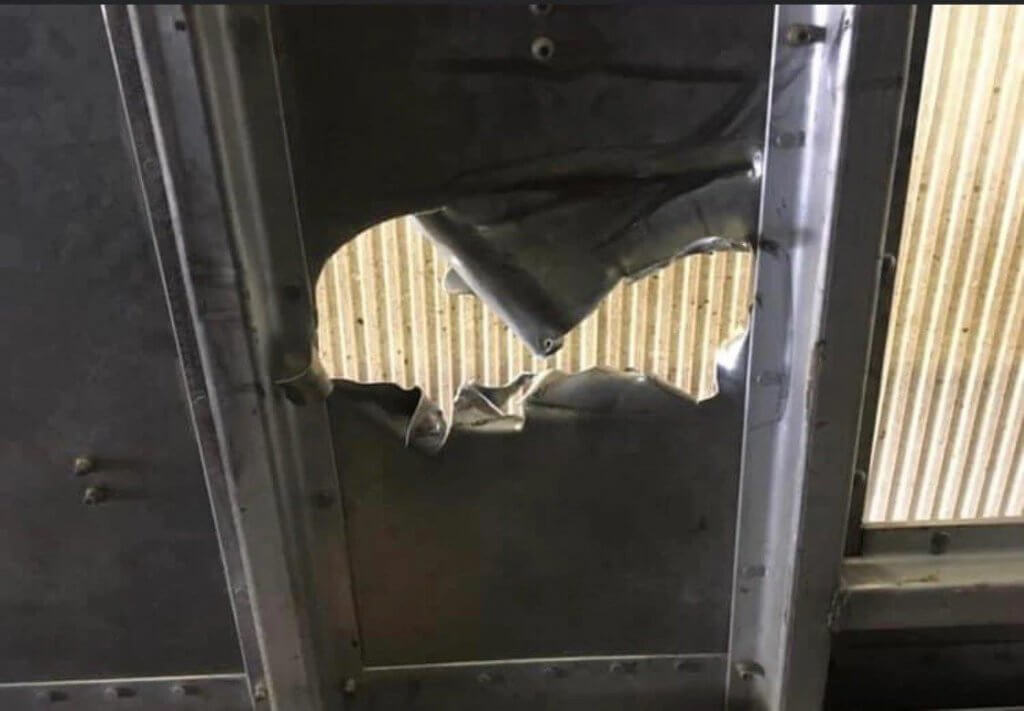
Stout bull buffalo horns broke through the side of the trailer one day, and the bull could have escaped—ripped it like a tin can, Tim says. But he did not. “Never had nothing come out yet,” he chuckles. TO
“That’s what happened one time.” When a bull buffalo smashed out a hole in the side of the trailer.
“Too many people working the outside got ahead of the bull and seeing them he spooked while I was trying to close the gate.”
He definitely prefers working alone inside the trailer when loading or unloading. It helps keep “these animals’ stress level at a minimum—better for the Bison.”
“Beautiful set of bull calves. Very quiet. First time on a truck an very little pressure to load an pretty much open the gate an they walked out behind me to unload.”
He loads them up—in the video you can see Tim’s boot and half a leg as he waves his flag—and deftly swings the divider gate at the same time.
Can that be a grocery-store plastic bag on the end of the long stick he’s waving?
He dips his head to the lower gate as a ‘Load of little ladies’ heads down a ramp into the front ‘Nose.’
A final wave and sweep of the plastic flag, shut the gate, and one more compartment is loaded and ready to go.
Can’t beat the 2 stage nose option. With it Set in the fat rail position ,it’s an easy in an out low stress operation. Works great ! pic.twitter.com/uQfMH3Xuqf
— Eastland Transport Ltd (@eastland09) May 27, 2021
Tim Omilusik calls riding in his truck, driving a load of yearlings or the big guys, being in his Happy Place. TO.
Riding his truck, driving a load of yearlings or maybe ‘the big guys.’ Getting out on the open road that stretches ahead for hundreds of miles—travelling south, east or west. That’s being in a happy place.
Winter Driving and Icy Roads
And yes, there’s some winter driving in January. Of course, there is, when you live 10.5 hours north of Minot, ND, with a full load of Bison and a huge truck!
On Jan 14, 2021, he shared: “Never have I ever felt the true force of the wind until last night. I’m loaded in this pic, parked. Highway is a sheet of ice. The wind literally blew my trailer sideways towards the shoulder. Scary stuff.”
He’s realistic. Frustrated, probably, but mostly concerned about those buffalo on the trailer. What’s best for them?
“I was NE bound–but forced to turn back.”
On March 17, “Wyoming got hit hard. Interstate I25 finally opened. I only was shut down for 12 hours but lots of trucks had been parked since Saturday when the storm hit.”
Another time he writes, “Been sitting at the truck stop for 2 days waiting for Sunday to load and I’m getting bored.
‘I had a close call a few years ago at a rest area in Montana. I was coming out of the restroom and caught a couple of animal rights activists trying to open the liftgate on my trailer and release the bison. They figured what I was doing was cruel and they should be set free to roam.
“After a heated argument, they got into their car and drove away.
“Now I padlock every door and gate to keep that from happening. Somebody could have been seriously injured or even killed.
“They had no idea what they were dealing with or the situation they were putting themselves and others in.
One day an insurance agent friend tells him about a retired veterinarian who was awarded a medal for bravery. He had fought off a bison bull who had another fellow down in a chute and dragged that fellow to safety.
Tim’s comment, “Very lucky he was there to help.”
Tim’s a bit reticent about who and where he’s serving his clientele—which I expect, many bison ranchers appreciate.
He gets the load where it’s going in the best shape possible, and no complaints.
His 2013 Kenworth Truck
I first encountered Tim Omilusik last year on the internet when John Hitch, editor of the magazine ‘American Trucker’ wrote an article on a ‘Day In The Life Of A Bison Hauler,’ featuring his work, dated Oct 21, 2020.
Turned out to be more than one day. In fact, Omilusik has been doing this for 24 years, and he told Hitch he learns something new every day when working with Bison.
Readers of the trucking magazine, of course, wanted to know about the kind of truck he drove—and the big trailer he hauled behind.
“What’s your current truck-trailer set up?” asked Editor Hitch.
“A 2013 Kenworth W900L. I ordered it brand new September of 2012. It was my first truck with a DPF (diesel particulate filter) on it. It took a little bit to get used to. It is equipped with a Cummins 550 ISX/1850 torque.
“I’ve had Cummins all my life and was pretty impressed with the performance of the new emission engine. I have got just under 950,000 miles on it.
“I’ve spec’d out a new truck, but with the way the economy is and the new prices, it’s pretty scary to jump into a new one. A truck I spec’d a little while ago came in at $265,000 Canadian (US $219,685). That’s just a lot of money.
As for the big trailer: “I have a 2017 Merrick quad-axle trailer—built a little bit heavier than your typical regular livestock trailer. It’s still pretty weak when it comes to hauling bison.”
A New Truck in Viper Red
But that was last year.
Since then Omilusik has upgraded to a new 2022 Peterbilt 389-special truck.
After all, he had driven his 2013 Kenworth nearly a million miles in less than 9 years—a total of 950,000 miles.
He ordered the new one in December—in a bright shiny red—a color called ‘Viper Red,’ his father’s favorite color—purchased in his honor, he says.
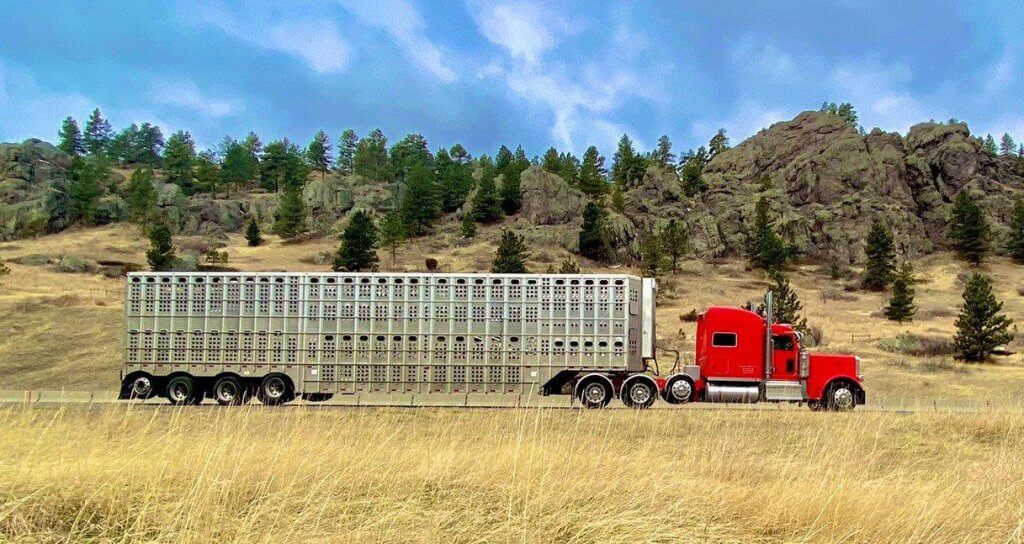
Tim ordered his new 2022 Peterbilt 389-Special in Viper Red—his father’s favorite color. Here it’s hooked up to his ‘Mobile Barn’ and ready to pick up a load of Bison. He can haul 100 feeder calves or about half that many cows at once. TO.
For a time in March Tim was between trucks. His old one was sold. The new one hadn’t arrived.
“8.5 years of my life I put into driving this truck and now she’s on her way to the new owner. I’m impatiently waiting to get into my other one so we can start some new miles.”
On April 7, 2021 the truck arrives, and he reports, “We are back in action!! Time to make some miles.”
A few days later the trailer—which Tim refers to as his ‘Mobile Barn’–is attached and ready to roll.
“I think it looks pretty darn good hooked up to the mobile barn.”
Next day he’s off. “Wow !! I missed this.”
A Day in the Life of a Buffalo Hauler
So what’s a day like in the life of a Bison hauler?
“Lots of prep work. I’ll get up, do my precheck, and get myself psyched up for the day. Hauling bison is no easy task.
“It’s a lot different than just hauling regular cattle. They’re quite a bit bigger and more aggressive and can cause quite a bit of damage to you, themselves and each other.
“You need to be calm and cool about it. Relax and have a plan in your head if something goes wrong.
“For instance, one night I stopped just north of the U.S. for a morning border crossing. I had a lot of bulls on, and they started fighting in the trailer. I was up all night keeping an eye on all the bison so they wouldn’t tear my trailer apart.
“I’ll haul slaughter bison or fats used for meat, most of which are to packing plants in Canada or the U.S.
“I haul feeder bison to feedlots and breeding stock all over as well. I have done some stuff for the Canadian government that was for scientific research, such as tuberculosis testing in bison.
“One load will be 55,000 to 60,000 lbs.
“You can get about 100 feeder calves on board or 45 to 50 fats at 1,200 lbs. each. Most runs usually take a few days to complete.
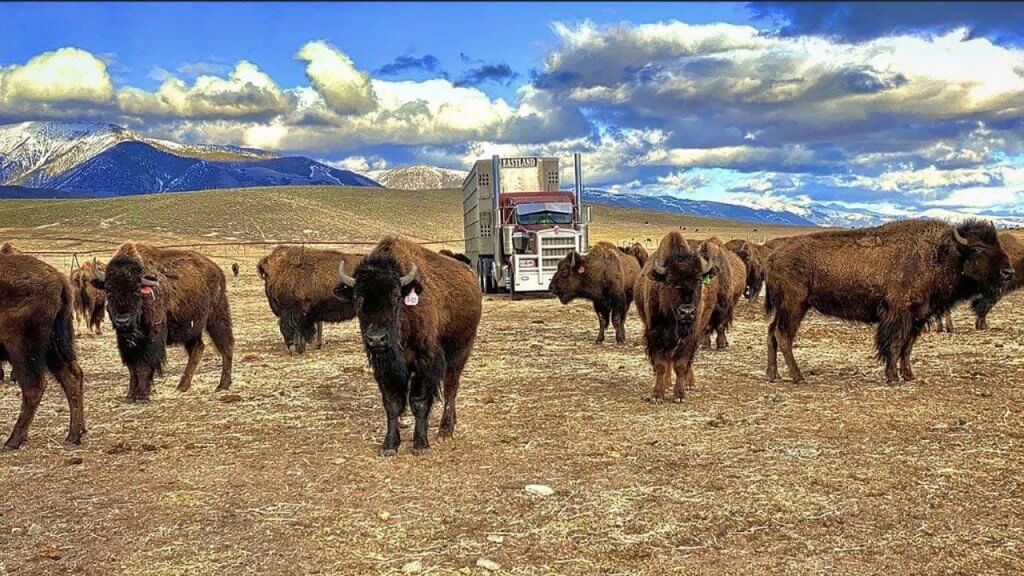
Tim Omilusik prefers working alone inside the trailer when loading or unloading. It’s better for the Bison, he says. It helps keep stress levels down. Credit TO.
“If I load in Canada, it’s a day to the border and then another one or two to the destination.
“USDA law mandates the time the animals can be on the trailer is 28 hours before they have to be unloaded for feed an water.”
Canada has similar rules.
“These runs could be short or long. I’ve hauled bison up to 2,000 miles on one trip. It can be a pretty stressful ordeal.
“I’ve also brought yak from the U.S. over the years. I had to quarantine them on the trailer for three days. They’re smaller, but a little more intimidating because their horns are so much longer.
“14 deer 1 moose. Driving wide eyed !!”
Partitioning the Load
Tim tells me that his latest trailer with two decks can divide into 6 or 7 compartments, depending on what he’s hauling.
“I try to load the same weights together. We never load buffalo of different sizes in one compartment—they would just kill each other.”
“I load the top first—depends on how the trailers are set up. For some in the Nose—the front compartment, which is a little narrower—they have to go down a ramp to get there.
“The Nose can also be in 2 decks—so they might go up or down a ramp. For big animals there’s only 1 level in the nose. For smaller animals of 400 to 700 pounds, it’s a double layer in the nose.
“The ‘dog house’ is on the back end.”
If the bison have been living together they have already established their ‘pecking order’ and they usually get along fine, he says.
“Recently I took a big load of 25 bigger bulls—from 3 different herds—2,000 to 2500 pounds. Put them together in smaller bunches.
“I have several dividers—can make 6 or 7 partitions in 2 decks. I had 3 in one pen in the nose, 4 in another, 5 and then 6.
“It went really good, smoothly.
“Some compartments are smaller than others on the trailer, so you have to watch where you place them. You could really run out of room before you can get them all on.
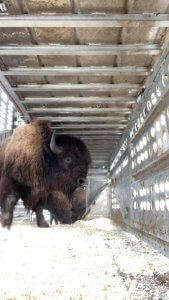
“Hauling Bison is a lot different than hauling cattle. Bigger, more aggressive and can cause quite a bit of damage to you, themselves and each other.” TO.
A reader asks, “If you end up with the least dominant one last and it won’t go into a compartment do you swap it out or ever just give up on filling the compartment?”
“I have never had to give up. Patience always seems to work,” Tim replies.
“If I have cows and small calves—I separate them into different compartments.
“I have never had any issues with bulls but cows seem to get pretty aggressive with one another.”
He loads them up. In the video you can see a boot and half-leg of Tim Omilusic waving his long-handled flag—and swinging the divider gate.
He dips his head to the lower gate as a ‘Load of little Ladies’ head down a ramp into the front Nose.
A final sweep of the flag, shut the gate and one more compartment loaded.
Then they are off. Mostly things go smoothly.
“These guys escaped an been hiding in the bush for quite some time before being caught. Loaded up an hauled out. They were very unhappy.
“This load of bulls this week definitely were a little on the wild side. No respect for anything. Kept me on my toes.”
The trailer looks strong and well built, and is re-enforced. But with the size and strength of the big bulls, Tim says they could smash through and get out if they really wanted to.
“One time when I was hauling herd bison weighing just under 3,000 pounds, a big bull didn’t like me on the roof an tore a hole through it trying to get at me.”
Tim was unloading from the roof, prodding with his flag to get one pen to leave the trailer.
“He ripped through the roof like it was a tin can. His horn came through right by my foot. A big hole—he could have come right through it.
“Bison horns have the strength to rip open even a re-enforced trailer like a tin can, so staying alert is key to staying safe for a bison hauler, Tim Omilusik warns.
“Never had nothing come out yet, though.
“Occasionally a ruckus is going on the the trailer.”
What do you do then? I wondered.
“Really can’t do anything. Usually there’s less fighting if you just keep going.”
Watering and Feeding Hay
“Feed and water can be a problem. You can’t unload bison and then load them up again. You can do that with cattle, but not bison.
“Their welfare is all I care about. I worry about the welfare of the animals. How to get them to their destination an unload safely
“On super long trips we have 2 drivers.
“If I think it’s going to be a problem I take a long garden hose, tubs for water and connect to a hydrant.
“Tubs are about the size of a half 50 gallon drum—I usually tie them to the walls so they can’t tip. All that has to be put together before leaving home.
“It’s a lot of work. I took a load to Missouri where we didn’t have access. I had to have hay and water. Setting all that up before we leave, it’s just a lot of work.
When they stop he tries to fill the animals up. They can also drink while travelling.
Sleeping in the Truck
“I always sleep in the truck—the trailer is behind, but they move around a lot more when we’re stopped. It all depends on their mood. Sometimes they are good. Other times they will thrash around the whole time.
“After 24 years of trucking you get used to it. Sometimes I stick in ear plugs.
“You definitely feel the movement with the larger ones. Most of the time they are pretty calm. It’s when you get stopped, there can be trouble.
“The animals mostly are bumping the walls and when you stop, they kick a lot and bump the walls.
“Little calves just weaned—300 to 500 pounds—they are agitated and paw the floor a lot.
“Buffalo carry their head low and sometimes one gets stuck between another animal’s legs. Sometimes they can get all tangled up together.
“Just gotta stop, use flags to split them up—usually just a couple animals together, but sometimes more. Need to reposition them.
“Bison are very smart—If one is tired they position themselves against the wall to lie down—out of the way. Where they have room to lie down.
“You learn something new every day when you’re working with bison. It’s a job that takes focus and patience. You always have to be alert and ready for anything.
“These runs could be short or long. I’ve hauled bison up to 2,000 miles on one trip. It can be a pretty stressful ordeal.”
At the end of the run, he reports a delicious meal.
“Friday night supper in the truck. Bison tenderloin compliments of my good friends of Bison Coulee Contracting. Baked potato, broccoli and a salad. I’m going to sleep well tonight!”
When Buffalo Don’t Want to Get Out
Then sometimes he arrives at the destination and the bison don’t want to leave the truck.
“On a long haul they get attached to their surroundings and sometimes they don’t want to get out.
“It’s happened to me three times this year with big herd bulls—they didn’t want to get out.
“Bison have their own mindset. If they don’t want to go, they’re not going to go. You can’t really force them.
And they have to come off the trailer in reverse order of the way they entered, right? One pen at a time? Right.
“Get off the ones you can. I went to bed in the truck with the trailer backed up to the unloading chute.
“You get whatever sleep you can. Some of them will walk off in the night, others early morning when it gets light and they can see where they’re going.”
“I love them to death, so much it’s hard to describe. They are a magnificent animal, so awesome.”
What age do you like the most, I asked Tim. The young ones? The big bulls? The grumpy old bulls?
“All of them. I like them all. The little calves right up to the big guys.
“The little red dogs—(as they call the newborns)—so frisky. I get to watch them bound around, so exciting to watch. How can you not just sit there and watch them?
“And the big guys—I’m just astonished how big and how strong they are. I love hauling them.
“Load of little ladies,” is his verbal output for one day.
“It’s a stressful job, yet it’s very enjoyable for me. Their welfare is all I care about.
“Hauling bison is no easy task.
“Once in a while I have to haul cattle—usually in the spring. But I’d rather just haul bison.
“I’d move them 365 days a year if I could, but it’s seasonal work.
Tim cleans his trailer after every load—to keep down any spread of disease. He’s usually alone for the job, wielding a shovel, bar and pitchfork.
And no, it’s not just manure and wood chips.
There’s more. There’s the hair, coming off in huge clumps in the spring.
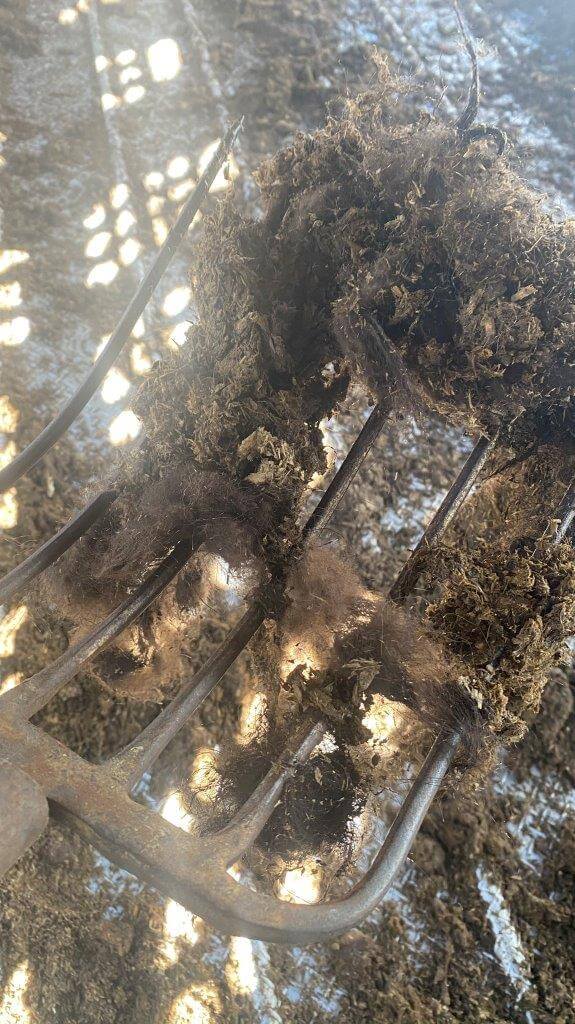
Buffalo shed winter hair in huge clumps in spring. TO.
Yes the Hair!
How does he clean buffalo hair out of the truck?
“It can be pretty overwhelming. During shedding season, you have more hair in the trailer than wood shavings or straw. I’ll find a place to shovel out everything and then find a washout [with a hydrant] to finish the cleaning.
“There’s usually so much hair it plugs up their system. I have been kicked out of more places than I can count.”
“The buffalo shed worst in spring. Yearlings and adults shed the most hair. And then they are also stressed from getting loaded in the transport trailer, so they rub on the walls. Not so much the calves.”
Some of his Twitter comments about hair:
“Shedding season. There will be more hair in the trailer than shavings when I’m unloaded.
“More hair than shavings on the floor by the end of the trip.
“Aftermath of hauling bison in the spring. Hair for days. Most loads during shedding season will leave more hair than there will be manure an shavings.
“And this is why washouts don’t like me coming around.”
“Get a leaf blower,” suggests one reader.
He rejects that with a genial, “Haha ya right. It’s packed in like concrete. Hence the pitchfork.”
And later: “Concrete. Exactly why it was used for many building projects for ages—hair, dung, straw.”
He’s right. I’ve seen those early homes in our Ukrainian communities! Hair, dung, straw and mud. Who knew you could build a home with that kind of ‘lumber?’ They did. And some are still standing—after more than a hundred years!
Wow !! I missed this. Happy to be back in my happy place. pic.twitter.com/ps0lqn4klJ
— Eastland Transport Ltd (@eastland09) April 13, 2021
Beautiful set of bull calves. Very quiet. First time on a truck an very little pressure to load an pretty much open the gate an they walked out behind me to unload. TO.
How Tim got Started Trucking
Tim explains how he got into trucking:
“After high school, I wanted to be a cowboy and started working on a feed lot close to home.
“They had their own truck and trailer, and they needed an extra driver, so I got my commercial driver’s license in 1998 and started driving an old 1980s Ford LTL 9000 and pulling a Wilson 50-ft. tandem.
“I did that for a couple of years.
“There was a commercial cattle hauler back home in Alberta. He had three trucks and I started working for him. and it took off from there.
“I just loved it. I got my first truck in 2009 and pulled as a lease operator until I got my own in 2010. I hauled cattle for quite a few years and hauled bison in between.”
Today Tim Omilusik owns the trucking company—Eastland Transport. He also has a wife and a 15-year old daughter who are involved in the business.
His daughter is into 4-H and Rodeo. She’s feeling somewhat disappointed right now because of Covid-19 restrictions and cancellations, which are still widespread throughout Canada. (I wish her many successful shows. As a former 4-H Leader and Extension Agent, I know how hard these kids work and what the shows mean to them. It takes patience—she will get through this and things will soon be better!)
Tim owns no buffalo, but would like to. “Maybe when I retire. Like to have a herd someday, maybe—20 to 50 cows.
“Every year is different—summer months trucking tends to dry up some until fall.
“Feed prices are so high this year—corn prices—that hurts the livestock feeders
Tough to feed animals—When that changes, more animals will be moving.”
Finally, there’s a photo of Tim’s shiny new red truck proudly parked, clean and ready to go again.

“Wow !! I missed this. Happy to be back in my happy place.” TO.
“Ah. That’s looks better. The bugs were starting to take control.
“Washed up. Washed out. Ready to rock n roll in the morning!”
Next day he’s off.
“Wow !! I missed this. Happy to be back in my happy place.”
And off goes Tim Omilusik in a clean truck to pick up another load of Bison.
All’s well in his Happy Place.
(Twitter @eastland09) Eastland Transport Ltd. Is for “Hire’ for all your Bison hauling needs locally and or long distance Canada or the USA. People can reach out to me at
Eastland Transport Ltd; Box 817; Coronation, Alberta Canada; T0C 1C0. Cell Phone: 1-403-578-8705. Email: eastland.transport09@yahoo.ca
—
Next: Secrets of the Buffalo Jump

Francie M Berg
Author of the Buffalo Tales &Trails blog


